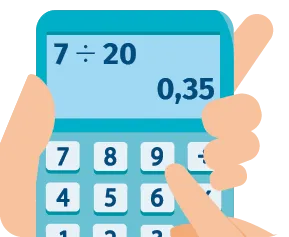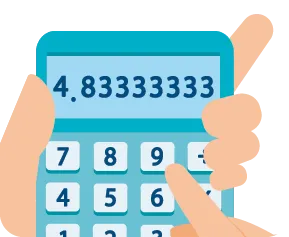Chapitre 4
Synthèse
Nombres décimaux
Ressource affichée de l'autre côté.
Faites défiler pour voir la suite.
Faites défiler pour voir la suite.
86
On considère le nombre 98,63.
1. Donner la partie entière de ce nombre.
2. Donner la partie décimale de ce nombre.
3. Que représente le chiffre 3 ?
4. Quel est le nombre de centièmes ?
5. Si ce nombre est un prix :
a. que représente le chiffre 3 ?
b. à combien de centimes correspond ce nombre ?
1. Donner la partie entière de ce nombre.
a. que représente le chiffre 3 ?
Ressource affichée de l'autre côté.
Faites défiler pour voir la suite.
Faites défiler pour voir la suite.
87Copie d'élève
Copie d'élève
On cherche si le nombre \frac{7}{20} est
décimal.
1. Lucie propose la solution suivante:


1. Lucie propose la solution suivante:
\frac{7}{20}=\frac{7 \times 5}{20 \times 5}=\frac{35}{100}
Donc \frac{7}{20} est un nombre décimal.
A-t-elle raison ?Donc \frac{7}{20} est un nombre décimal.
2. Paul a directement
effectué le calcul ci-contre.
Arrive-t-il à la même
condusion que Lucie ?


Ressource affichée de l'autre côté.
Faites défiler pour voir la suite.
Faites défiler pour voir la suite.
88
Compléter le tableau suivant en
utilisant l'exemple de la première ligne.
| 87,5 | 87+0,5 | \frac{875}{10} | 87+\frac{5}{10} |
|---|---|---|---|
| 4+\frac{25}{100} | |||
| 0,769 | |||
| 8301+0,09 | |||
| \frac{61254}{1000} |
Ressource affichée de l'autre côté.
Faites défiler pour voir la suite.
Faites défiler pour voir la suite.
89
Un élève tape le calcul
29 \div 6 sur sa calculatrice et
obtient le résultat ci-contre.
1. Il dit : « J'ai obtenu un nombre décimal ».
Son affirmation est-elle exacte ? Justifier.
2. Donner un arrondi de ce nombre au
millième près.


Ressource affichée de l'autre côté.
Faites défiler pour voir la suite.
Faites défiler pour voir la suite.
90
Trouver l'intrus dans la liste suivante.
Ressource affichée de l'autre côté.
Faites défiler pour voir la suite.
Faites défiler pour voir la suite.
91
Trouver l'intrus dans la liste suivante.
Ressource affichée de l'autre côté.
Faites défiler pour voir la suite.
Faites défiler pour voir la suite.
92
Voici la copie d'écran du travail d'une élève
sur une feuille de calcul d'un tableur.




1. a. Quel nombre lit-on dans la cellule A2 ?
b. Quel nombre lit-on dans la cellule B2 ?
c. Dans la cellule C2, elle saisit =A2+B2. Pourquoi obtient-elle 42,07 ?
2. Quelle formule faut-il saisir dans la cellule
C3 pour obtenir l'écriture décimale voulue ?
Ressource affichée de l'autre côté.
Faites défiler pour voir la suite.
Faites défiler pour voir la suite.
93
Voici les temps en finale du 100 \mathrm{m} haies
femmes lors des Jeux olympiques de Paris.
1. Écrire les temps sous la forme d'un nombre mixte.
2. Ordonner ces athlètes dans l'ordre croissant de leur temps.


- Nadine Visser : 12 \mathrm{s} 434 25
- Alaysha Johnson : 12 \mathrm{s} 93
- Cyréna Samba-Mayela : 12 \mathrm{s} 34
- Grace Stark : 12 \mathrm{s} 434 28
- Jasmine Camacho-Quinn : 12 \mathrm{s} 36
- Masai Russell : 12 \mathrm{s} 33
- Devynne Charlton : 12 \mathrm{s} 56
1. Écrire les temps sous la forme d'un nombre mixte.
Nadine Visser :
Alaysha Johnson :
Cyréna Samba-Mayela :
Grace Stark :
Alaysha Johnson :
Cyréna Samba-Mayela :
Grace Stark :
Jasmine Camacho-Quinn :
Masai Russell :
Devynne Charlton :
Masai Russell :
Devynne Charlton :
2. Ordonner ces athlètes dans l'ordre croissant de leur temps.
1.
2.
3.
4.
5.
6.
7.
2.
3.
4.
5.
6.
7.


Ressource affichée de l'autre côté.
Faites défiler pour voir la suite.
Faites défiler pour voir la suite.
94
Pour chacun des nombres suivants, donner
l'arrondi à l'unité et l'arrondi au dixième.
Arrondi à l'unité
Arrondi au dixième
Arrondi à l'unité
Arrondi au dixième
Arrondi à l'unité
Arrondi au dixième
Arrondi à l'unité
Arrondi au dixième
Arrondi à l'unité
Arrondi au dixième
Arrondi à l'unité
Arrondi au dixième
Ressource affichée de l'autre côté.
Faites défiler pour voir la suite.
Faites défiler pour voir la suite.
95
Pour déterminer des grandeurs (longueur ou
masse par exemple), on utilise des unités de
mesure (\mathrm{m} ou \mathrm{g} par exemple). Pour adapter
l'unité à la grandeur, on utilise des prefixes
de l'unité. Par exemple 1~000~\mathrm{m} = 1~\mathrm{km}.
1. Compléter le tableau suivant.
2. Compléter les égalités suivantes.
3. Pour convertir des unités de mesure, on peut s'aider du lien avec les unités de numération.
Compléter les égalités suivantes.
1. Compléter le tableau suivant.
| 1~000 | Milliers / Kilo | ||
| 100 | Centaines / Hecto | ||
| 10 | Dizaines / Déca | ||
| 1 | Unités | ||
| 0,1 | Dixièmes / Déci | ||
| 0,01 | Centièmes / Centi | ||
| 0,001 | Millièmes / Milli |
2. Compléter les égalités suivantes.
a. 1~\mathrm{m} =~ \mathrm{km}
b. 0,1~\mathrm{m} =~ \mathrm{dm}
c. 1~\mathrm{mg} =~ \mathrm{g}
d. 100~\mathrm{g} =~ \mathrm{hg}
3. Pour convertir des unités de mesure, on peut s'aider du lien avec les unités de numération.
Compléter les égalités suivantes.
a. 76~\mathrm{g} =~ \mathrm{dag}
b. 987~\mathrm{mm} =~ \mathrm{m}
b. 987~\mathrm{mm} =~
c. 3~\mathrm{hm} + 14~\mathrm{m} =~ \mathrm{m}+14~\mathrm{m} =~ \mathrm{m}
d. 8~\mathrm{g} + 65~\mathrm{cg} =~ \mathrm{kg}+ \mathrm{kg}=~ \mathrm{kg}
d. 8~\mathrm{g} + 65~\mathrm{cg} =~
Ressource affichée de l'autre côté.
Faites défiler pour voir la suite.
Faites défiler pour voir la suite.
Club de maths
Ressource affichée de l'autre côté.
Faites défiler pour voir la suite.
Faites défiler pour voir la suite.
96
Les participants d'un jeu cherchent à sortir d'une pièce équipée
d'un digicode dont le pavé numérique est constitué des dix chiffres
de 0 à 9 et d'une virgule. Le code est constitué d'une partie entière
et d'une partie décimale. Le but est de découvrir le code grâce aux
deux indices suivants.
Indice 1 : Le code est un nombre décimal composé de quatre chiffres admettant 1 comme partie entière et tel que le chiffre des dixièmes et des millièmes soit le même.
Indice 2 : Le nombre de dixièmes de ce nombre est le double du produit du chiffre des centièmes et de celui des millièmes.
Quel est ce code ?
Indice 1 : Le code est un nombre décimal composé de quatre chiffres admettant 1 comme partie entière et tel que le chiffre des dixièmes et des millièmes soit le même.
Indice 2 : Le nombre de dixièmes de ce nombre est le double du produit du chiffre des centièmes et de celui des millièmes.
Quel est ce code ?


Une erreur sur la page ? Une idée à proposer ?
Nos manuels sont collaboratifs, n'hésitez pas à nous en faire part.
j'ai une idée !
Oups, une coquille
